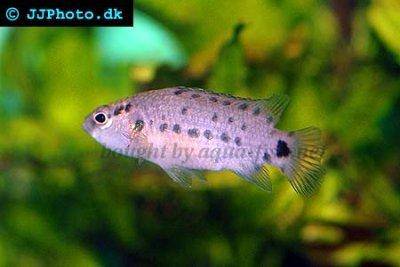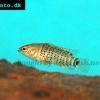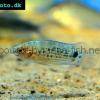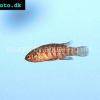Badis blosyrus
Scientific name: Badis blosyrus
Common name: N/A
Family: Badidae
Usual size in fish tanks: 4 - 5 cm (1.57 - 1.97 inch)
014
Recommended pH range: 6.3 - 7
Recommended water hardness: 8 - 15°N (142.86 - 267.86ppm)
0°C 32°F30°C 86°F
Recommended temperature range: 23 - 26 °C (73.4 - 78.8°F)
The way how these fish reproduce: Spawning
Where the species comes from: South Asia
Temperament to its own species: peaceful
Temperament toward other fish species: peaceful
Usual place in the tank: Middle levels
Short Description
Badis blosyrus is a peaceful, small freshwater fish native to India, ideal for community aquariums with similar calm species. Although not widely known in the aquarium trade, this fish is appreciated by enthusiasts for its subtle beauty and fascinating behaviors. To thrive, Badis blosyrus requires a well-planted tank with plenty of hiding places, such as rocks, driftwood, and caves. A spacious tank with a balanced ratio of one male to several females is recommended to minimize territorial disputes and encourage natural behavior.
Origin
Native to Asia, Badis blosyrus is found in the freshwater rivers and streams of India. These habitats are typically slow-moving and feature dense vegetation, offering shelter and hunting grounds for this species. Their natural environment provides valuable insights into their tank requirements.
Tank Requirements
Badis blosyrus thrives in aquariums of at least 50 liters (13 gallons) with stable water parameters. Maintain a temperature range of 23-26°C (73.4-78.8°F), a pH between 6.3-7, and water hardness of 8-15°N (142.86-267.86 ppm). Use a soft, sandy substrate and add plenty of plants, rocks, and caves to replicate their natural habitat. Floating plants are also beneficial for diffusing light, creating a calming environment. Ensure good filtration with gentle water flow to maintain water quality without stressing the fish.
Food and Feeding
Badis blosyrus has a preference for live and frozen foods and may refuse dry foods entirely. Offer them a varied diet that includes brine shrimp, bloodworms, daphnia, and glassworms. Feeding small portions multiple times a day mimics their natural feeding habits and ensures they receive adequate nutrition. Be cautious not to overfeed, as uneaten food can quickly degrade water quality.
Compatibility
Badis blosyrus is a peaceful species that can coexist with other calm and non-aggressive tankmates. Suitable companions include small schooling fish like tetras, rasboras, and Corydoras catfish. Avoid housing them with overly active or aggressive species, as this can cause stress. Maintaining a ratio of one male to several females helps prevent territorial conflicts among males.
Sexing
Males can be distinguished by their elongated dorsal and anal fins, as well as their more vibrant coloration compared to the drab appearance of females. These differences become more apparent during breeding, as males display heightened colors to attract mates.
Breeding
Badis blosyrus are cave spawners, making the addition of coconut caves, clay pots, or other similar structures essential for breeding. After the female lays eggs, the male guards the nest and protects the fry once they hatch. When the fry become free-swimming, they are left to fend for themselves. Feed the fry newly hatched brine shrimp or finely powdered fry food to support their growth.
Lifespan
With proper care, Badis blosyrus can live for 5-8 years. Ensuring a stable and clean environment, along with a varied diet, is crucial to their longevity and well-being.
Pictures
Bought by aqua-fish.net from jjphoto.dk.






 Badis
Badis  Burmese
Burmese  Scarlet
Scarlet